Adaptations Overview
How Animals Survive
Giant Anteater Adaptations
Rattlesnake Adaptations
Word of the Week
Adaptation
An adaptation is something an organism has or does that helps them survive. Adaptations can be physical or behavioral and develop over many generations!
Adaptations are what make organisms perfectly designed for their environment.
Species Spotlight
North American Porcupine
Erethizon dorsatum
North American porcupines are the second-largest rodent in North America, following the American beaver. They can be found in many habitats in Canada, the United States, and northern Mexico. Porcupines found in wooded areas are known to be great climbers and will search for food and avoid predators up in the trees. In the northern part of their range, winters can be very harsh. While they do not hibernate, porcupines often hide in their dens during extreme weather. North American porcupines are normally solitary but can be found in small groups while hiding in their dens. During the winter, they survive off of bark and twigs, and in the warmer months, they feed on leaves, seeds, grasses, and fruit.
You can’t picture a porcupine without its quills, which are actually just special hairs! Quills are made of keratin, just like our hair and fingernails, and are used to defend porcupines from predators, like lynx, coyotes, great horned owls, mountain lions, and fishers. When threatened, porcupines will turn their backs to the predator and raise and shake their quills as a warning. You may have heard that porcupines can shoot their quills, but this is just a myth. In order for the predator to get stuck with a quill, they have to bump into it. This may seem easy to avoid, but porcupines can run as fast backward as they can forwards, making them experts at sticking their attackers!
BRAIN BLAST
Porcupines are experts at avoiding predators. What other animals have adaptations to protect themselves from predators? Make a list and discuss!
Conservation Corner
Adapting Takes Time
There is no denying that humans are impacting the planet. As we cut down forests, release harmful gases into the atmosphere, and alter animal habitats, plants and animals are trying to adapt to the new conditions in their ecosystem. The production of greenhouse gases from burning fossil fuels is affecting weather around the world and causing many problems for wildlife.
In the past, animals have adapted to the gradual changes in their environment. Humans are now changing the environment so fast that plants and animals are not able to adapt quickly enough. Luckily, the Earth is resilient and it's not too late for us to reverse these effects!
Why Do Animals Adapt?
Match each adaptation below to its correct function!
Adaptations Challenge
Identifying Animal Adaptations
Select an animal that lives in your habitat and identify adaptations that help it survive the challenges your habitat presents. Think about how the animal...
- Finds and collects food
- Avoids predators
- Survives climate challenges (cold winters or hot summers)
- Builds or finds a shelter
- Attracts a mate
Glossary
Adaptation
Something an organism has or does that helps them survive in their environment.
Aestivation
A prolonged state of inactivity in both ectotherms and endotherms that occurs during the summer.
Behavioral Adaptation
Things organisms do or ways they act that help them survive.
Brumate
A state of inactivity in ectotherms (cold-blooded animals) during the winter months.
Camouflage
The ability for an organism to blend into their surroundings usually to hide from prey or predators.
Carnivore
An animal that eats other animals.
Climate
Weather conditions in a region over a long period of time.
Ectotherm
An animal that relies on the external temperature to regulate their body temperature (reptiles and amphibians). Also known as cold-blooded.
Endotherm
An animal that regulates their body temperature internally (mammals and birds). Also known as warm-blooded.
Evolution
The theory that heritable characteristics of a species change over generations to help that species better survive their environment.
Greenhouse Gases
Gases in the atmosphere that trap heat from the sun close to the Earth.
Herbivore
An animal that eats mostly plants.
Hibernation
An extended state of decreased activity and metabolic rate in endothermic (warm-blooded) animals during winter seasons.
Mimicry
Occurs when two species that are not closely related look similar.
Natural Selection
The theory that nature favors individuals within a species who have characteristics that make them more successful in their environment.
Omnivore
An animal that eats both plants and animals.
Physical Adaptations
Body parts or other physical parts of a plant or animal that help them survive
Predator
An animal that hunts other animals for food.
Prey
An animal that is hunted and eaten by another animal.
Shelter
A protected space where animals will go when there is danger or to raising offspring.






